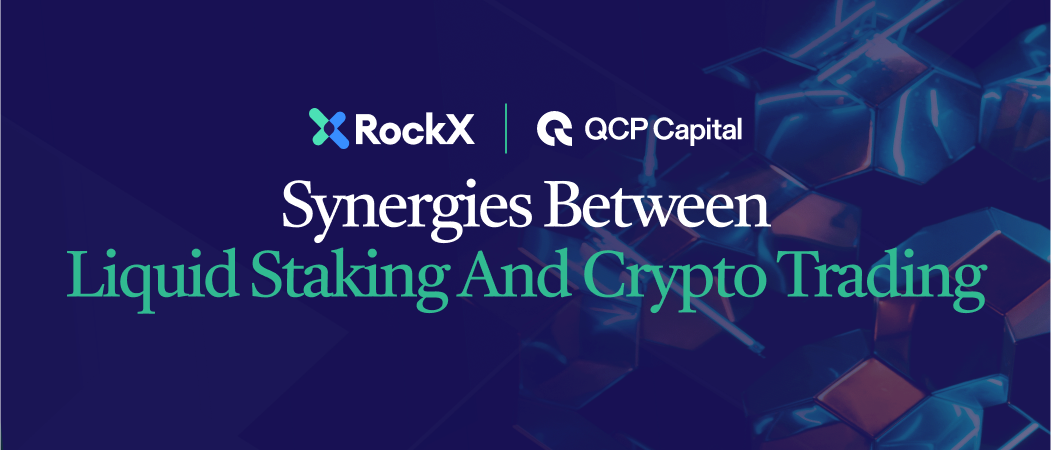The rise of decentralized finance (DeFi) presents novel opportunities for investors to seek yields through digital assets. One of these new and novel ways is liquid staking. In Q3 2023, RockX garnered 5,000 ETH staked on Bedrock by Amber Group’s flagship digital asset platform, WhaleFin, signalling institutional interest in liquid staking.
Liquid staking quickly gained popularity among retail investors when it first surfaced in 2020 due to its flexibility and the ability to retain liquidity while earning yield on digital assets. Now, institutional investors are also turning to liquid staking to maximize their digital assets. In this article, we explore the reasons for institutional interest in liquid staking and explore the synergies between liquid staking and institutional digital assets trading.
The Rise of Liquid Staking
Previously, staking one’s tokens to earn yield from a validator, would subject their tokens to be locked up. This is often referred to as native staking. With native staking, stakers who wish to withdraw their tokens from a validator require an unbonding period, typically ranging multiple days, thus subjecting them to liquidity risk.
Liquid staking solutions introduced the possibility of staking to support Proof of Stake blockchains without sacrificing liquidity, and instead gaining capital efficiency. Through the use of smart contracts, users can now lock their tokens up to stake, but receive representative tokens that can be traded, or utilized for other DeFi positions while accruing yield.
Since its inception, the popularity of liquid staking has skyrocketed. Currently, the total value locked (TVL) of liquid staking protocols sits above $20b, according to DeFiLlama, and overtook the TVL of lending protocols as of March 2023.
Up until recently, however, most liquid staking protocols served primarily retail audiences. Institutions looking to adopt liquid staking as an asset class were unable to access it due to a lack of deep liquidity in the protocol and unclear security standards. Currently, there are only two liquid staking protocols available that cater to the unique needs of institutions – Bedrock, developed by RockX, and Liquid Collective, developed by Alluvial.
A Perfect Match: Liquid Staking and Crypto Trading
Institutions navigating the landscape of liquid staking often encounter challenges concerning the security of their assets and compliance with stringent regulations. Co-mingling of funds and potential exposure to illicit sources can pose significant risks. Hence, liquid staking designed for institutions needs to act as a solution to these issues. By adhering to stringent security protocols, liquid staking can be designed to meet institutional needs. This opens avenues for diverse institutions to pursue an asset class with capital efficiency while adhering to strict security standards to ensure fund safety. Through this platform, institutions can generate yield from their digital assets while ensuring their funds remain secure from attacks. Furthermore, institutions are rewarded with spendable tokens that represent their staked ETH and its associated rewards. Institutional-grade liquid staking empowers firms by enabling enhanced liquidity utilization and capital efficiency within a tight security framework.
With liquid-staked ETH, users can trade, spend, or employ yield-farming strategies on DeFi protocols. With the rise of liquid staking, we have witnessed the birth of innovative solutions that have ushered in a new paradigm of how users can utilize and trade their newly minted liquid assets – Primitives such as Pendle enable users to take the reins of their own yield by allowing them to tokenize and sell their future yields. New stablecoin issuers like Ethena have sprung up, creating eUSD, a yield-bearing stablecoin that provides holders with yield generated from staked ETH and basis arbitrage.
The Marriage of CeFi and DeFi
Institutional-grade liquid staking solutions should, ideally, achieve the best of both DeFi and CeFi. By building smart contracts and protocols fully on-chain, the supply of the liquid staking token can be easily verified by anyone with an internet connection. On top of that, if the liquid staking protocol has strategic partnerships, the tokens should be usable on DeFi protocols for trading and yield-farming strategies. Additionally, state-of-the-art security infrastructure and fully audited on-chain contracts are pivotal to the development of a liquid staking protocol that wants to serve as a bridge between CeFi and DeFi.
Zhuling Chen, CEO of RockX, explains, “Liquid staking opens up a whole new world of opportunities for users to maximize their yield, diversify their portfolios, and increase their financial literacy. This changes the game and is beneficial for the entire community, not only in terms of financial gain, but also ecosystem robustness, and technological innovation. Liquid staking has the potential to be a real game-changer for the financial industry.”
As much as liquid-staked ETH has finally enabled formerly illiquid assets to be made liquid for trading and yield-farming purposes, there are certain yield-farming strategies on DeFi protocols that can be rather risky – whether these are leveraged credit positions through recursive borrowing, or yield-farming highly inflationary tokens. Currently, most offerings for liquid staked tokens in DeFi are either utilized for interest-bearing stablecoins or on yield strategies (yield management, recursive borrowing, etc.).
We have seen first-hand, how the liquid staking space has evolved, and have innovated safer and more professional solutions in utilizing one’s liquid staked assets. As a pioneer and global market maker in crypto options, QCP Capital believes that more new solutions to managing liquid-staked assets for institutional investors will continue to emerge. Options trading on liquid staked assets are one of the ways which offer holders of liquid staked assets the ability to hedge their positions while earning yield, or earn additional and diversified form of yield through selling of options on liquid staked ETH collateral.
Stan Low, Head of Investments, QCP Capital
This creates an opportunity for all to capitalize on institutional-grade solutions from both the DeFi and CeFi worlds. Through the marriage of these solutions, users can access a much broader market, maximize, and diversify their yield in a safe and secure manner.
Institutional Digital Asset Management: The Way Forward
Liquid staking provides a new way to earn yield on digital assets. By combining liquid staking with derivatives trading, users can potentially access deeper liquidity, take advantage of market volatility, and protect their positions from outsized movements, than they would have otherwise. Additionally, users can use their liquid staking tokens to collateralize their derivatives trading, allowing them to access greater leverage and thus greater profits. By leveraging the rise of liquid staking, institutions can unlock greater liquidity and a more holistic and inclusive financial asset portfolio, taking advantage of not just DeFi, but also other traditional financial tools such as trading.
To know more about QCP Capital, follow our Telegram, Website, Twitter and LinkedIn.









